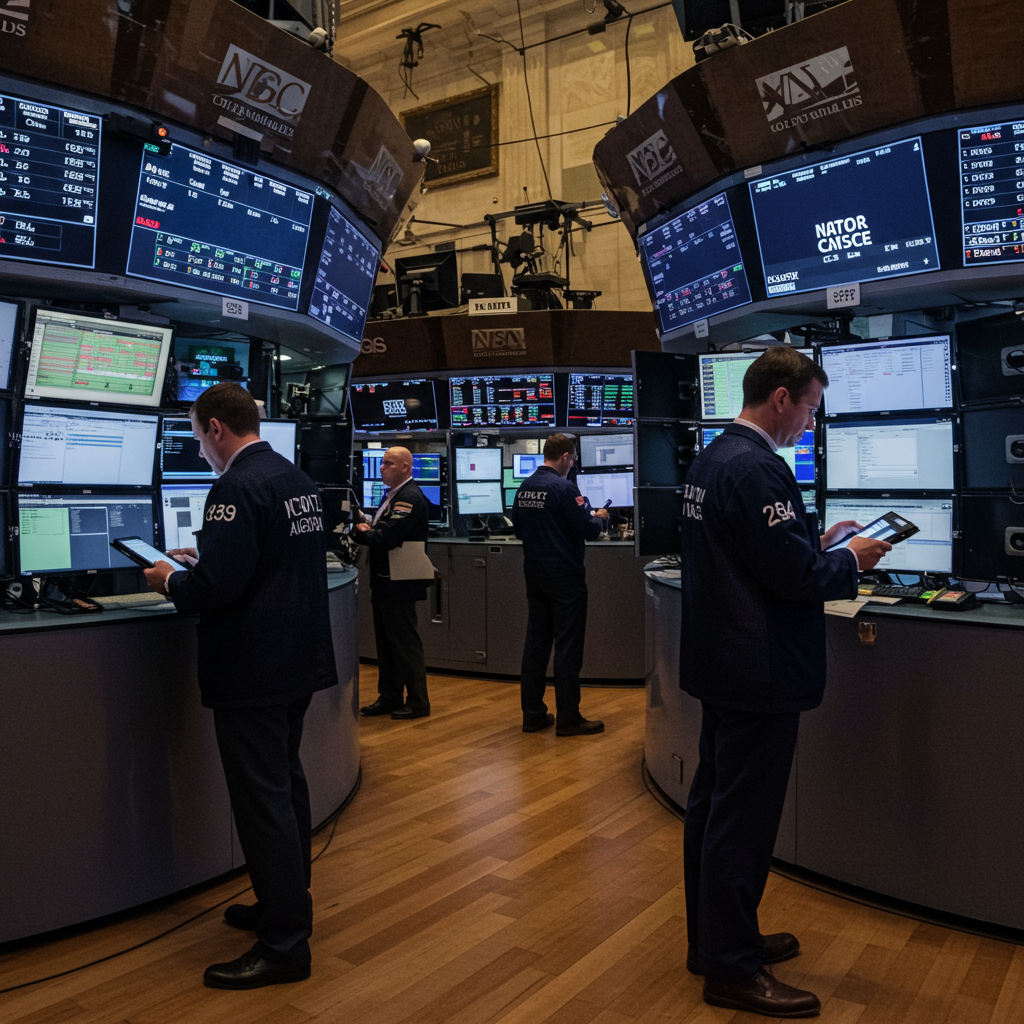President Donald Trump has signaled a potential revival of trade tensions with new tariff announcements. Yet, the financial hub of Wall Street appears notably unfazed this time around. Investors seem to be looking past the immediate headlines, viewing the tariff threats less as firm policy and more as strategic maneuvers aimed at negotiation. This muted reaction marks a significant shift compared to previous instances where Trump’s trade actions sent shockwaves through global markets.
Wall Street’s Unexpected Calm Amidst Tariff Talk
Following President Trump’s latest tariff campaign announcements, which included extending deadlines and expressing openness to negotiation, global markets remained surprisingly calm. Asian stocks saw gains, while US markets showed only minor fluctuations. The Dow experienced a slight dip, the S&P 500 saw a minimal decrease, and the tech-focused Nasdaq posted a small gain. These relatively minor movements signal that investors largely interpret the new tariff proposals as leverage for talks, rather than definitive actions.
This contrasts sharply with earlier periods, such as the “Liberation Day” tariffs, which triggered significant market plunges. Experts note the difference. One market analyst described the recent news as an “aftershock” that markets were prepared for, rather than the “seismic event” of months prior. Three months after initial sweeping tariff threats, Wall Street seems less reactive to the rhetoric.
Why Investors Are Calling the “Bluff”
Several factors contribute to Wall Street’s current stance. The explicit extension of deadlines and Trump’s own remarks about the “firm, but not 100% firm” nature of the deadlines and their status as “more or less” final offers, leaving the door open for different proposals, fueled the perception of negotiation tactics.
This environment has led some investors to embrace what’s been dubbed the “TACO trade.” This market bet operates on the premise that “Trump Always Chickens Out” on major tariff threats, particularly if markets react negatively. This perceived pattern encourages investors to anticipate a potential reversal or scaling back of the most severe proposals.
Crucially, external analysis highlights a growing belief that China has effectively “called Mr. Trump’s bluff” in the current phase of the trade dispute. According to assessments from sources like the Wall Street Journal, China has seemingly gained the upper hand this round. Unlike earlier responses, which were more restrained, China has adopted a comprehensive “tit-for-tat” approach.
This includes significant actions like restricting US access to critical rare-earth minerals, halting deliveries of Boeing aircraft, actively seeking alternative global suppliers for crucial imports like food and natural gas, and deploying regulatory measures against American companies operating within China. This escalated and multi-faceted retaliation has reportedly intensified pressure on the US side.
Reports suggest that President Trump may be beginning to acknowledge the economic realities of the situation. This shift is partly attributed to direct warnings from major US retailers. CEOs from companies like Walmart, Home Depot, and Target reportedly visited the White House to express serious concerns. They cautioned that the growing impact of tariffs would soon lead to rising prices for American consumers and potentially result in empty store shelves. This feedback underscored that the tariff consequences were far more severe than initially characterized as a “little disturbance.”
Furthermore, China has publicly refuted claims of ongoing trade negotiations. Beijing has stated clearly that no talks are currently happening and will not resume unless the existing high tariffs are completely revoked. This firm precondition from China reinforces the perception that they are not backing down easily, adding another layer to why Wall Street might view the US tariff threats as less potent than before.
What Else Is Driving the Market?
With tariff anxieties seemingly relegated to a lower tier of concern, investors are increasingly focusing on other significant market drivers. Artificial intelligence’s impact on corporate earnings, the underlying strength of economic data, and the potential for Federal Reserve interest rate cuts are now seen as more influential factors.
Market forecasts from major financial institutions reflect this shift in focus. For example, Bank of America recently increased its year-end S&P 500 forecast, citing expectations of higher market levels. Similarly, Goldman Sachs revised its S&P 500 projection upwards, specifically mentioning expectations of sooner-than-anticipated Fed rate cuts, the fundamental strength of large US companies, and investors’ willingness to discount near-term earnings softness potentially linked to trade friction.
Analysts note that markets are starting to “turn the page” on tariffs, directing their attention instead to how technologies like AI are shaping company performance and the continued resilience of economic indicators. Even the clarity provided by the recent passage of the US budget bill is viewed as more relevant to market sentiment than the ongoing tariff uncertainty.
One portfolio manager commented that tariffs now sit at the lower end of investor concerns. The market seems to have “moved on,” operating under the assumption that potential volatility stemming from tariffs would likely lead President Trump to yield. Investors are incorporating tariff risks into a broader analysis of Trump’s policy agenda.
Remaining Uncertainty and Potential Risks
Despite the prevailing calm, some analysts caution against complacency. They argue that the modest market reaction might be overly reliant on the expectation of successful tariff negotiations or a continued belief in the “TACO trade” strategy. Some experts are less certain that markets should be so sanguine, pointing out that the proposed tariff rates are quite similar to those from the earlier, more disruptive “Liberation Day” period.
While the overall market reaction was muted, some specific commodities did see significant movement. For instance, copper prices reportedly surged to record highs following President Trump’s statement about potentially levying a substantial tariff on imports of the metal. This serves as a reminder that targeted tariffs can still have pointed impacts.
Some analysts suggest that President Trump might be more inclined to press forward with his tariff agenda now, potentially feeling empowered by recent political “victories” and the stock market’s proximity to record highs.
The situation remains fluid. While negotiators may be given more room to maneuver as deadlines are potentially extended, requiring markets to price in little immediate concern, it remains prudent to consider all possible scenarios. The narrative around tariffs is highly adaptable, and President Trump has demonstrated a capacity for unilateral action, maintaining a position that allows for unexpected policy shifts.
Upcoming economic data, such as inflation figures, will provide further insight into the broader economic landscape and the potential flow-through effects of tariff policies. In the meantime, market participants will continue to watch closely for any concrete developments on trade deals or new tariff impositions.
Frequently Asked Questions
Why is Wall Street reacting calmly to Trump’s new tariffs?
Wall Street’s muted reaction stems from the perception that President Trump’s latest tariff threats are primarily negotiating tactics rather than firm policy. Investors note the extended deadlines and Trump’s explicit statements indicating openness to different offers. This leads many to believe in the “TACO trade” concept, anticipating that Trump may back down if markets react negatively, reducing concerns about significant economic disruption from these specific announcements.
What are investors focusing on instead of Trump’s tariff threats?
Investors are currently prioritizing other factors believed to have a more significant impact on market performance. Key areas of focus include the influence of artificial intelligence on corporate earnings, the overall strength of current economic data, and expectations regarding potential future interest rate cuts by the Federal Reserve. Major banks have even raised their year-end S&P 500 forecasts based on these more positive fundamental assessments, rather than dwelling on tariff uncertainty.
How has China responded differently to Trump’s latest tariff actions?
Unlike earlier responses, China’s reaction this time has been described as a robust “tit-for-tat.” They have reportedly escalated countermeasures, including restricting US access to critical rare-earth minerals, halting Boeing jet deliveries, seeking non-US suppliers, and using regulators against American firms. Furthermore, China has publicly denied any ongoing trade negotiations and stated talks will only resume if existing high tariffs are completely removed, taking a firmer stance than in previous rounds.
References
- timesofindia.indiatimes.com
- www.aol.com
- <a href="https://www.huffpost.com/entry/wall-street-journal-trump-realityn6809e409e4b09e23ad05526e”>www.huffpost.com
- www.newsweek.com



